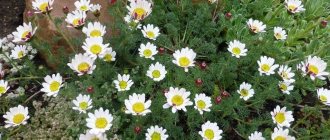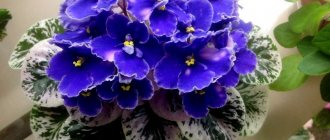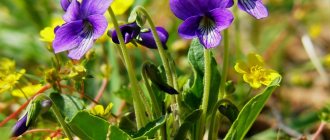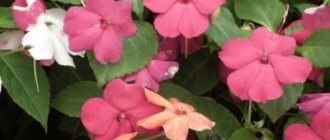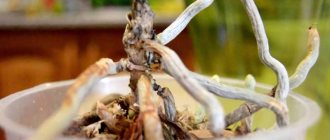There are many different types of flowers that resemble violets. They are sometimes called garden violets because they can grow outside of indoor conditions. Landscape designers often use them to decorate flower beds or garden paths. This type of plant is now very popular among gardeners. Among the flowers similar to violets are: primrose, Turkish carnation, petunia and many others, which are varied in care, but are similar to this delicate, homely flower.
Flowers that look like violets
The most famous and popular perennial flowers similar to house violets are:
- Achimenes;
- deikun;
- gloxinia;
- Streptocarpus.
Achimenes
If you see that a flower in a pot looks like a violet, then most likely it is Achimenes. The flowering plant resembles a violet with flowers consisting of five petals.
Achimenes.
A striking similarity is noted in the early period of development of the culture , when the plant has not yet become very elongated and sits in a pot as a strong bush. In adulthood, the culture is ampelous. Achimenes petals can be of different colors. Including:
- purple;
- bluish;
- pink;
- light lilac;
- whitish-purple;
- scarlet, etc.
People who grow violets will find it easy to grow achimenes. Decorative culture requires the same care as violets.
Achimenez will feel great in a bright room, but where there is no direct sunlight. It needs high air humidity. To do this, the flower is often placed in the kitchen area.
It should be watered carefully and no more than three times a week. Warm, settled water is suitable for the procedure. The watering can is not directed at the greens; only the root zone is watered.
Stagnation of water should not be allowed. This will cause rotting of the root system. The pot should have plenty of drainage.
Important! Achimenes does not grow in the winter season. In winter, its aerial part dies off, and the pineal rhizome rests.
Deikun
The more famous name of the flower is Cinderella's Dream . The ruffled semi-double edges of the neat petals are reminiscent of a ball gown. This flower is a representative of a new selection of violets. The edges of the petals, which have a terry-net structure, stand out in color from the main petal.
Usually the petal is snow-white in color, and the corrugated edges are covered with a lilac, pink, purple or lilac border. The leaves are moderately velvety, curved-wavy in shape. The upper part of the leaf blade is emerald, the lower part is brick or reddish-green.
Violet Cinderella's dream (Deikun).
Deikun does not tolerate cold, heat, direct sunlight, darkness, or drafts. It is best to keep it in a lighted, ventilated room, where it is about +19…+23 degrees. The soil substrate must be loose. The soil should be moistened every 2 days.
Gloxinia
A violet that looks like a bell is gloxinia, an ornamental crop that resembles a violet with its leaf blades. They are round, slightly elongated, strong. Light velvety pubescence and light veins are noticeable. Leaf color is green.
Gloxinia (close-up photo of the flower).
The leaves do not form rosettes like those of a violet, but grow tightly to each other. The color range of gloxinia is extensive . The prevailing petal colors are:
- lilac-lilac;
- scarlet;
- pink;
- snow-white, etc.
The plant prefers to be in a bright place with diffused bright lighting. The air should not be dry. Otherwise, the stem and leaves with flowers will wither.
Like violets, gloxinia should not be sprayed with water from a spray bottle. To humidify the air, it is recommended to place a container of water in the room. Due to the inadmissibility of drops getting on the green mass, gloxinia should be watered at the root or pour water into a pan.
Gloxinia needs hibernation every year. The dormant period begins in the fall. At this time, the bush is pruned, and the pot is placed in the basement or underground, where it is dark and cool.
Tubers need moisture even in winter. They should be watered once every 20-35 days.
Advice! The culture is responsive to feeding. It is recommended to apply mineral fertilizers to the soil every 50 days, which contain no nitrogen or very little of it.
Streptocarpus
A bright decorative specimen that attracts attention with its fancy miniature neat flowers. The color can be very different - from blue, dark burgundy to snow-white and pinkish.
Streptocarpus.
This indoor plant blooms in the summer . For good growth, a lighted place is necessary. It would be ideal to place it on a windowsill facing east.
The plant is resistant to short-term drought and quickly recovers after watering. It is best to water it every 2-3 days through a tray. In winter it goes to rest.
Reproduction
Decorative yarrow variety of varieties, planting and care
Saintpaulias can be propagated by leaf cuttings, part of a leaf, dividing the bush, peduncles (chimera varieties) and seeds (slowly, the variety is not guaranteed, so it is rare).
- Rooting a leaf or part of it is the most popular, fastest and most effective way to propagate Uzumbara violets. It is best to carry it out in spring or summer, but it can be done at any time of the year. An adult, healthy leaf is selected, but not from the outer row of the rosette (they are already too old and weak), but from the second. It is better to break it off carefully so that the stalk of the petiole does not remain in the socket. The longer the petiole (up to 3–4 cm), the better - if its tip begins to rot, you can always shorten it and try again. From variegated varieties, choose the lightest leaf. The bottom of the petiole is cut at an acute angle to increase the area for root formation and treated with charcoal. The leaf needs to be dried for about 20 minutes, but if you do not have time to root the prepared leaf in a few hours, store it in a damp cloth in a bag so that it does not lose moisture and does not wither.
- A more reliable method of rooting is in water: this way you can see what is happening to the cutting and, if necessary, you can intervene. It is better to take a narrow glass container for this - such that the sheet “gets stuck” in it along the width and does not fall through, but you can also take a small disposable cup. To prevent the leaf from falling into the water, you can cover the container with water with a sheet of paper with a hole through which the petiole is directed into the water - but so that it does not touch the walls of the container. Place the cutting in a bright, warm place without drafts. The water needs to be changed regularly; it will be useful to put a piece of coal in it. It can be planted in the ground when the roots reach 1.5 - 2 cm.
- Leaves can also take root immediately in the ground; a mixture of peat with garden soil or sphagnum moss (it is sterile and prevents rotting) and a small container (about 100 ml) is better suited for this. Make a hole 1.5 - 2 cm in the ground, place the cutting in it at an angle of about 45 and lightly sprinkle it with earth. To prevent the leaf from falling to the ground and rotting (especially if you have a very short petiole), you can “lean” it onto the edge of a pot or glass. It is not necessary to cover the seedling with a jar, but it is possible. Roots appear in 3 – 4 weeks, and “babies” appear in 1.5 – 2.5 months. The mother leaf can be removed when the young ones reach 3cm.
- Often, in a pot with an adult violet, young rosettes of leaves appear - basal children. In this case, you can propagate Saintpaulia by dividing the bush, planting young plants, and all the varietal characteristics of the mother plant are guaranteed to be preserved. The grown-up stepchildren, which have managed to form their own root system, are simply separated during the next transplant and planted in a separate container as an adult plant. If the rosette of leaves is still small and has almost no roots, it is better to plant it in a mixture of peat with sand or garden soil, or in sphagnum moss, and cover it with a jar or film until rooting. In this case, do not forget to regularly ventilate the greenhouse and slightly moisten the soil.
Street flowers that look like violets
Violet-like flowers are often planted as decorative decorations in flower beds and garden paths. Almost all varieties of “street violets” are perennial plants. These colors include:
- primrose;
- petunia.
Primrose, or primrose, belongs to the primrose family; the appearance of the flower resembles a violet.
. Primrose is perennial; flowering begins after the snow has completely melted. Blooms until the end of May. More than 500 species of primrose are known in nature. It looks like a small bush (no more than 30 cm in height). Leaves with pronounced veins, green or dark green. The flowers are usually collected in umbellate or spherical inflorescences, and solitary ones are also found. Petals of various colors: yellow, red, blue, lilac, sometimes two-color, with a clearly defined center.
Petunia is a garden herbaceous bush with a taproot system. The stems are branched, thin, green in color. They can be short or tall. Petunia leaves are small in size, green or dark green in color, alternate, covered with fine fluff. The inflorescences are single, of various colors, monochromatic or two-colored.
Viola garden
The plant belongs to the violet genus. Unlike pansies, garden viola reaches a height of 30 cm. It blooms very profusely and for a long time. Flowers perceive shade better than bright sun. In sandy soil the flowers can be very small. Water the plant as needed, but try not to water too much.
If diseases occur, gardeners recommend spraying the plant with a solution of calcium and soda.
With proper care, each of the plants can be grown indoors or in the garden. Plants that are similar to violets are usually not too demanding and can be grown even by amateur gardeners.
Dog violet
In May, on forest edges, in thickets of bushes, under the canopy of sparse forests, and even in open places - meadows, fields, along the banks of reservoirs - the dog violet (Viola canina) blooms.
Dog violet in a sparse forest
Why they called her that - I don’t know, sorry! It is clear that this is a literal translation into Russian of the Latin name. The plant is not too noticeable, but interesting. The flower, like other violets, is five-membered. But the petals are already one color, mostly pale blue. There may be several of them on one stem, on long peduncles. The leaves of the dog violet are stem, alternate, on cuttings. Basal leaves appear only after flowering.
Like many spring-blooming plants, dog violet is a myrmecophilous plant. Indeed, ants (“myrmekos” in Greek) take the most active part in the distribution of its seeds. In June, fruit boxes already ripen in place of the flowers. The ripe fruit cracks, its leaves curl, scattering the seeds. But each seed is also equipped with a special body to attract ants, like lungwort, liverwort or corydalis. Ants take away the seeds, and they can spread quite far.
But I still can’t pinpoint this violet!
Swamp violet?
Quite large leaves in a basal rosette, heart-shaped at the base. Single pale blue flower. Grows in spruce-birch forest on fairly moist soils. I looked through several determinants, but I’m not completely sure...
For an accurate identification, for that matter, the plant had to be picked or dug up in order to carefully study its structure. I just took a photo and can tell from the photo.
Most likely, this is the marsh violet (Viola palustris).
Primrose
A perennial flower similar to a violet that begins to bloom immediately after the snow melts. The flowering process in good weather conditions lasts until the end of May. And although the plant resembles a violet, it is a small bush up to 30 cm in height, and the flowers are single and resemble the shape of an umbrella.
Color variety: blue, pink, lilac. Primrose also has more than 500 different species.
Reference. Primrose can be planted in any climatic conditions; it takes root well in any soil. It does not require abundant watering; it can additionally be fertilized with mineral supplements.
Petunia
And although petunia looks like a violet with its flowers, it is a large, growing bush. Its leaves are small in size, and the bush itself can be tall or short. The flowers are solitary and can come in more than 20 different colors. At the same time, they can be monochromatic or combine 2 or more colors.
Reference. Gardeners warn: to grow petunia, the soil must be neutral and loose, and sand can be used when sowing.
Read how to grow a real garden decoration - Petunia.
Achimenes
Indoor flowers called Achimenes can bloom 2-3 times a year. The buds bloom quickly and delight with long-lasting flowering. The plant, which resembles a violet with its flowers, is very unpretentious in maintenance, but needs sufficiently humidified air. And flowers react to temperature changes.
This plant is popular because anyone can grow it at home. Achimenes dot and blueberry ripple are considered the most similar to violets. The color variety is very wide, bright colors, with a beautiful transition from light to darker shades.
Centopoly
Centopoly or indoor violet. The fringed centopoly has gained popularity among gardeners. It is sometimes called curly. The edge of the violet is white at the right temperature. And the colors of the plant are very diverse: from light pink to dark purple. The color is also affected by the quality of the soil.
[adsp-pro-6]
You can use mineral fertilizers, which also affect the color of the plant. Centopoly needs good lighting and does not tolerate temperature changes.
Indoor flowers - “doubles”
Among the pets, the violet has “doubles”. The most popular are:
- gloxinia;
- streptocarpus;
- deikun.
Gloxinia is often confused with indoor violet.
. Does not require special conditions of detention. A perennial herbaceous bush with a short stem (5 to 20 cm). The leaves are dense with pronounced veins. The inflorescences are double, of various colors, with clear splashes of white and burgundy color.
Streptocarpus is a perennial herbaceous plant that resembles a violet. It can be annual or perennial. It is considered a close relative of Saintpaulia.
The leaves of Streptocarpus are wrinkled, green in color, with pronounced veins. The inflorescences are simple, double, petals of various colors: pink, white, blue, red, purple.
Deikun, or Cinderella's dream, belongs to the genus of hybrid Saintpaulias. It has dark shiny leaves with a purple back. The flowers are creamy-white, double, collected in a rosette. The petals are most often two-colored, edged with fringe. Flowering is frequent and abundant.
Turkish clove
Gardeners love Turkish cloves for their brightness and unpretentiousness. There are low-growing plants that resemble violets, as they reach a height of 15-20 cm. And there are tall plants, more than 80 cm in height. Turkish carnation can also be planted in the garden. The big disadvantage of these flowers is that they are highly susceptible to pests.
The bright, variegated colors of the plant always attract attention.
This plant requires careful care, namely:
- weed removal;
- frequent loosening of the soil;
- frequent watering;
- fertilizer;
- protection from pests.
Pansies
Most often, this plant is grown as a biennial. They bloom in the spring, the first year. Gardeners call them violets if the plant grew in the wild. It is low-growing, and the flowers are completely similar to violets, but much larger in size.
[adsp-pro-5]
In the summer, pansies can be grown in large pots on the balcony of the house. The plant requires careful watering and bright lighting. Gardeners recommend using mineral fertilizers, which will also affect the color and brightness of flowers.
Read about how to grow pansy flowers from seeds.
Gloxinia
Flowers in pots, whose name is Gloxinia, are considered very sophisticated and special. And although they have similarities with violets, the stem of gloxinia is much thicker and stronger. The flowers reach a diameter of up to 7 cm, and the plant itself requires a lot of space and light.
There are several conditions under which the plant will take root and bloom for a long time:
- Fertilizing with nitrogen-free fertilizers.
- Large pot size.
- To ensure flowering lasts all year round, you need to build an insulated rack and additional lighting.
Methods for getting rid of pests and diseases
The fight against the negative consequences of diseases must be included in flower care at home. If the violet is exposed to excessive soil moisture, rot may develop at the base of the stem, which weakens the plant. It should be replanted in a new soil mixture and the watering regime adjusted.
Light yellow stains and spots on the crown can cause the proliferation of sucking pests - greenhouse thrips. Adult insects reach a narrow body length of up to 1.5 mm and are brown in color. The larvae have a yellowish tint. To get rid of it, dust the plant with pyrethrum.
If jumping small springtail insects (springtails) colonize indoor flowers, the violet may die due to rotting of the roots, as evidenced by these insects. When there are few insects, they provide benefits by eating rotting tissue. Large populations begin to harm when they reach healthy roots. The soil is treated with pyrethrum, crushed shag or crushed citrus peels.
Lyubka bifolia
A plant that looks more like an orchid than a violet. The plant is not grown at home, and it does not always take root in the ground. It grows more in forest areas with high humidity, but requires good lighting.
If you grow this plant in the garden, it needs frequent watering and additional fertilizer. This plant is not very popular among gardeners due to its whimsicality and difficulty of care.
Growing and caring for Uzambara exotica
When the right conditions are created, a representative of the Gesneriaceae family is able to bloom all year round. To create comfortable conditions, you need to choose the right soil, know how to water, prune and propagate the plant, what and when to fertilize the plant with, and how to replant the flower if necessary.
It is necessary to choose the right pot: it must be at least 13 cm deep. When growing African exotic at home, you must adhere to the optimal temperature - +22...+24 °C. The pet does not tolerate drafts; it must be protected from direct sunlight and sudden changes in temperature. The plant prefers to grow in loose and light soil; the substrate should absorb moisture well and allow oxygen to pass through. Specialized substrate can be purchased in specialized stores. Recommended soil composition:
- peat;
- leaf soil;
- coniferous soil;
- turf soil;
- river sand.
Saintpaulia is capricious in terms of watering. Experienced flower growers recommend choosing a middle ground; the soil should not be allowed to become waterlogged or dry out. Watering the plant must be done with settled, warm tap water. To maintain the necessary humidity in the air, experts recommend spraying moisture around the flower.
It is recommended to avoid getting water on leaves and flowers; the plant may get burned.
For full flower growth, additional lighting must be installed. Artificial light sources should illuminate the plant for about 13 hours a day.
You will have to fertilize your homemade Uzambara violet regularly, especially if the plant looks healthy but does not bloom. Feeding is carried out once every 14 days, with a special complex of vitamins and minerals. The necessary fertilizer can be purchased at a specialized store.
Care during the flowering period
Caring for gloxinia during the growing season is almost the same as caring for Uzambara violet:
- Gloxinia is installed in a warm, bright place, protected from drafts. Lighting should be diffused. Avoid direct sunlight on leaves and flowers. They cause burns and even death of the plant. If the length of daylight is less than 14 hours, gloxinia leaves stretch vertically; if there is enough daylight, they are arranged horizontally.
- The soil in the pot with gloxinia should not dry out. It should also not be over-watered to prevent the roots from rotting. Water the flower carefully, avoiding getting it on the leaves and flowers. Drops of water cause stains on them. Take soft, settled water; its temperature should be slightly above room temperature. 15 minutes after watering, excess water is drained from the pan.
- To successfully grow gloxinia, moist air is needed. If it is dry, the leaves turn yellow and the buds fall off. But you can’t spray the flower because of the large number of small fibers on the leaves and stem. Therefore, they spray water near the plants or place trays with water nearby. You can place a pot on them, but its bottom should not be in water. In this case, the roots will rot and the gloxinia will disappear.
- In order for the flowers to be large and bright, gloxinias need to be fed. A special mineral fertilizer has been developed for them, which can be bought at a flower shop. You can use regular fertilizer for flowering plants, but apply it at half the recommended dose.
Streptocarpus
A plant that reaches a height of 30 cm and can be grown at home in a pot. The flowers and leaves are slightly hairy and the flowers are umbrella-shaped.
The plant has many advantages:
- Easy to care for.
- Lush and long flowering (more than six months).
- If the plant does not bloom, it can be planted outside.
- Ease of reproduction.
We offer you to read a complete review of Streptocarpus indoor flowers.
Deikun
The plant, called Deikun, is also called Cinderella's Dream. An unusually beautiful plant, usually with white flowers, which may be slightly tinted in a different color. At the same time, the flowers are not very large, the maximum size is 4 cm. In good conditions, the plant blooms very often and with many buds.
Gardeners warn that not everyone can grow deikun, because drafts and bright sun can affect the quality of the plant, and it may germinate without flowering.

